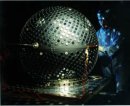|
Amateur
Satellite Building * Amateur
Space Radio
Starshine
3 Brightens the Sky
Two university student satellites
also orbited

Starshine 3 during assembly at the Naval Research
Lab. Image by Michael A.Savell and Gayle R.
Fullerton
The sky now holds a bright, new shiny ball
called Starshine
3. The Starshine and three other microsatellites were
placed into their orbits on September 29, 2001 by a Lockheed
Martin Athena
rocket launched from Kodiak
Island in Alaska.
Last
Frontier State Launches First Orbital Mission - Space.com
- Sept.30.01
Starshine 3 is covered with 1500 small mirrors
that were polished by thousands of grade school and high school
students from around the world.
Starshine 1 was a similar but smaller (0.5m) ball that
was launched from the space shuttle Discovery in June 1999.
The mirrors on the balls make
the craft visible and the students can track the satellite
when it passes. The orbits are measured
from these observations. Over time these measurements indicate
the orbital decay rate, which in turn can be correlated to
the solar activity that heats the atmosphere. (Starshine 1
burned up in the atmosphere in Feb.2000.)
Unlike Starshine 1, Starshine 3 also carries
an amateur radio transmitter powered by solar cells. Students
will learn how to receive telemetry from the satellite and
use the data to measure the spin rate of the sphere and how
it is effected by eddy currents generated by the interaction
with the earths magnetic field.
Starshine 2 will actually go into orbit later
in in November 2001 from the shuttle Endeavor. This sphere
is of similar size to Starshine 1 but also has a simple nitrogen
thruster to spin up the satellite, which will "enhance
the rate at which sunlight will flash from its mirror".
Two other microsatellites put into orbit also
carry amateur radio transceivers. PCSat
was built by students at the Naval Academy and Sapphire
was constructed by students at Stanford University.
(The fourth payload, Picosat, was built by
Surrey
Satellite Technology in Britain and will test several
technologies for the Dept. of Defense.)
PCsat's
primary mission (besides simply giving the students plenty
of hands on experience in satellite building) is to "provide
mobile and Handheld Satellite digital communications for amateur
satellite operators worldwide." It also has Emergency
Status and Reporting (SAR) Capability that allows emergency
messages from remote locations to be saved and later downloaded
when in range of a receiver.
Sapphire
will test a micromachined infrared sensors and other technologies
for nanosats.
As of Sept.30, all three of the student satellites
had successfully transmitted telemetry and seemed to be operating
properly.
[Forty
Thousand Children Help Build Space "Disco Ball" - National
Geographic News - Oct.4.01, A
Disco Ball in Space - Science@NASA - Oct.9.01 ]
|



